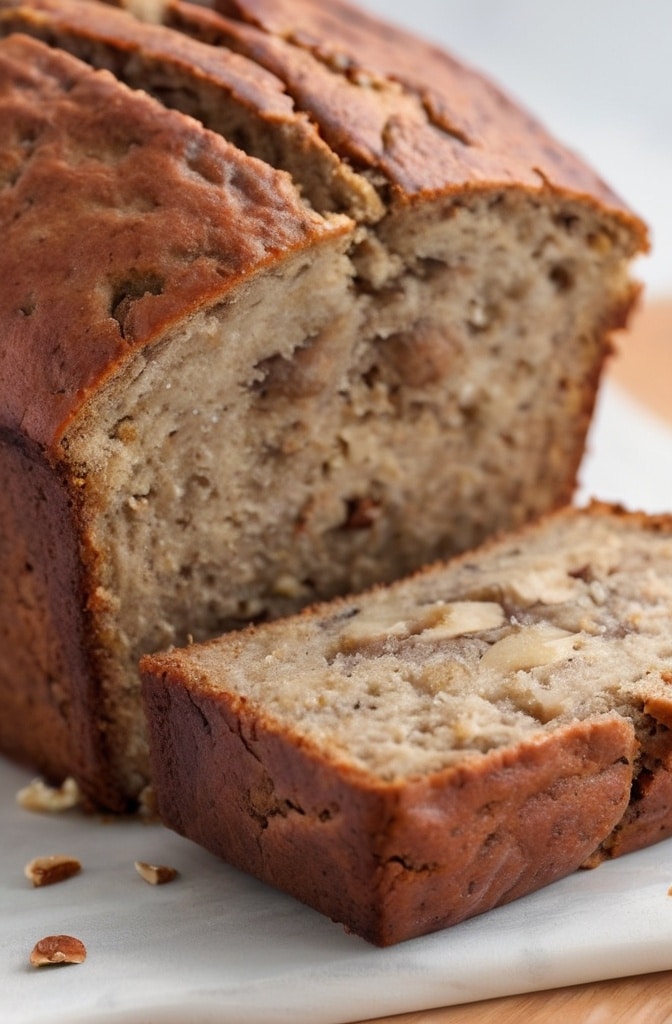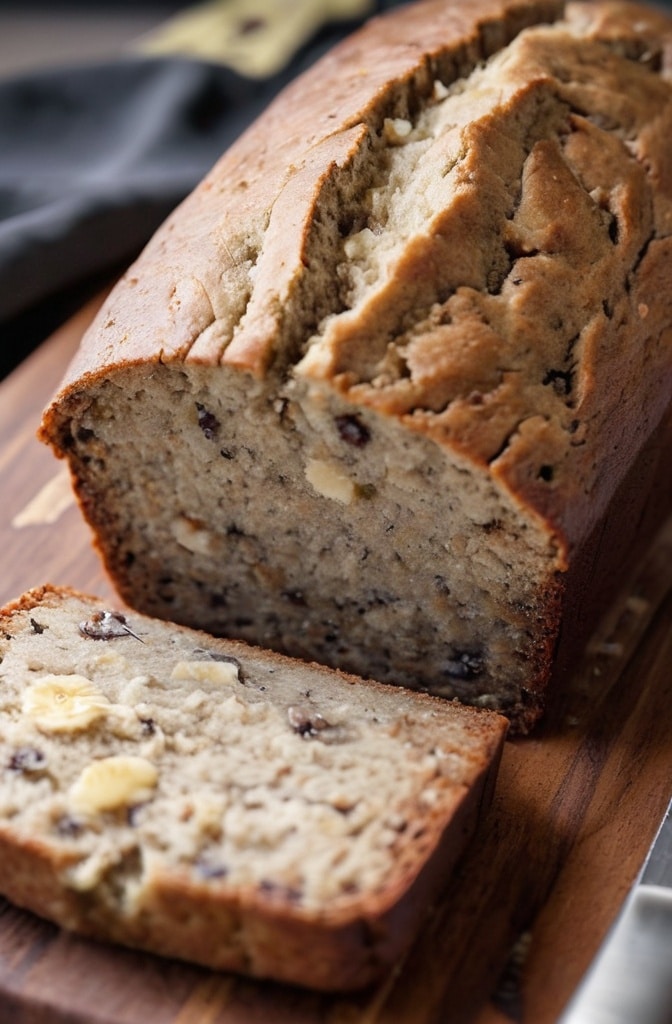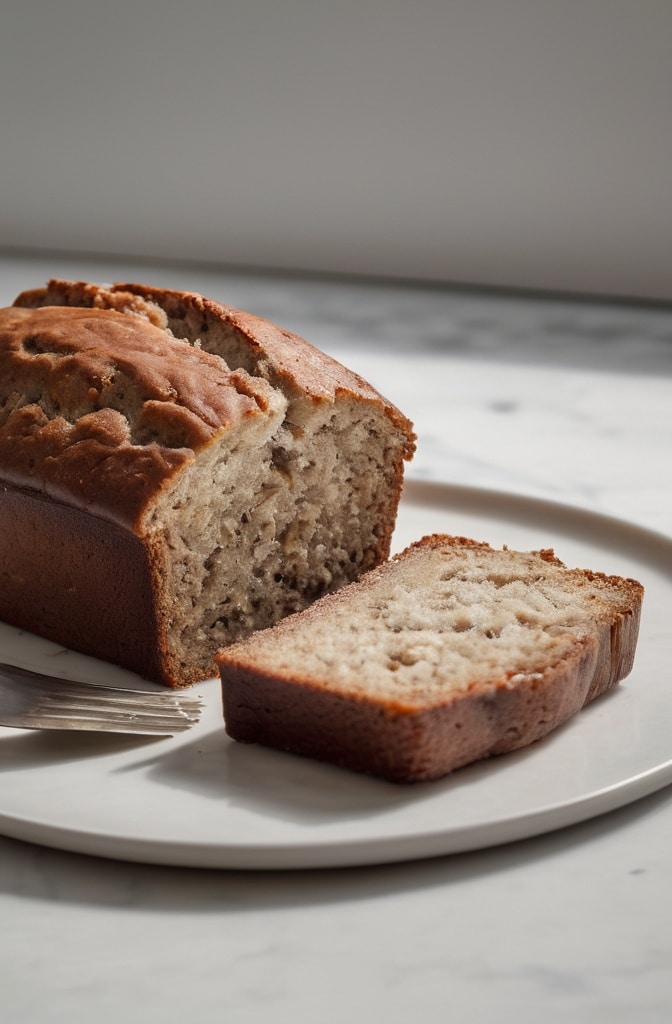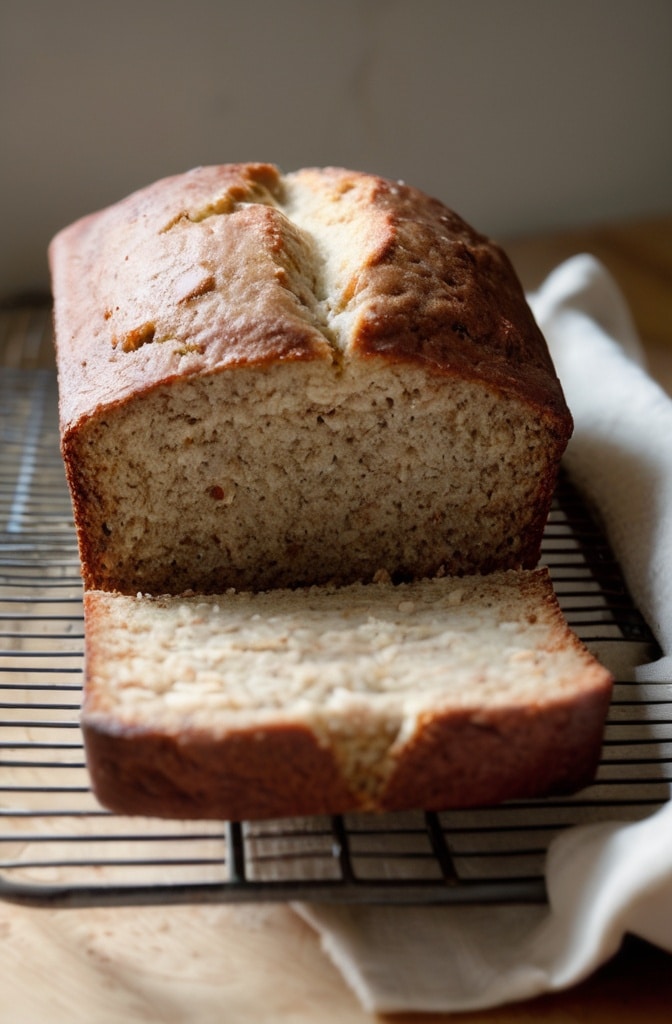The gentle hum of my oven has always been a comforting soundtrack in my kitchen. Particularly when I’m baking banana bread. There’s something almost magical about the transformation of spotty, overripe bananas into a moist, fragrant loaf that fills the house with an aroma that whispers “home.” But not just any banana bread buttermilk banana bread. This elevated version of a classic staple brings together the tangy complexity of cultured dairy with the sweet earthiness of ripe bananas.
What makes buttermilk banana bread special? Its the perfect balance of moisture and texture. The acidity in buttermilk not only tenderizes the gluten for a softer crumb but reacts with baking soda to create a beautiful rise. This isn’t your average banana bread recipe it’s a carefully crafted formula developed through years of professional experimentation and countless taste tests.
Ingredients & Substitutions

For the Banana Bread Base:
- 3 medium-sized very ripe bananas (about 1½ cups mashed)
- ⅓ cup melted unsalted butter, slightly cooled
- ¾ cup granulated sugar
- ¼ cup light brown sugar, packed
- 1 large egg, room temperature
- 1 teaspoon vanilla extract
- 1 cup buttermilk, room temperature
- 2 cups all-purpose flour
- 1 teaspoon baking soda
- ½ teaspoon salt
- ½ teaspoon ground cinnamon
- ¼ teaspoon ground nutmeg
Optional Add-ins (choose 1-2):
- ½ cup chopped walnuts or pecans
- ½ cup chocolate chips
- ⅓ cup dried cranberries or raisins
- 2 tablespoons poppy seeds
The bananas should be properly overripe—I’m talking dark spots covering most of the peel. This isn’t just for sweetness; those dark spots indicate that the starches have converted to sugars and developed deeper flavors. If your bananas aren’t quite ready, you can speed up the process by placing them in a paper bag with an apple overnight.
No buttermilk? No problem. Make a quick substitute by adding 1 tablespoon of lemon juice or white vinegar to 1 cup of whole milk. Let it sit for 5-10 minutes untill it thickens slightly. Plant-based cooks can use the same technique with almond or oat milk for a dairy-free version, though the texture will be slightly different.
The combination of granulated and brown sugar isn’t random—granulated sugar provides sweetness and structure, while brown sugar adds moisture and a subtle molasses flavor that complemets the bananas. You could use all brown sugar for a deeper caramel note, but the texture will be slightly denser.
Step-by-Step Instructions

Preparation
- Preheat your oven to 350°F (175°C). Grease a 9×5-inch loaf pan with butter, then dust with flour. Alternatively, line it with parchment paper, leaving an overhang on the sides for easy removal.
- In a large bowl, mash the bananas with a fork until mostly smooth but still with some small chunks for texture. Some texture in the mash contributes to the character of the final bread—avoid pureeing them completely.
- Stir the melted butter into the mashed bananas. The warm butter should be cool enough not to cook the egg when added later but still fluid enough to incorporate easily.
Mixing the Batter
- Add both sugars to the banana-butter mixture and whisk until well combined. This initial creaming helps dissolve the sugar crystals for a smoother texture.
- Beat in the egg and vanilla, then pour in the buttermilk and mix well. Don’t worry if the mixture looks slightly curdled; this is normal due to the acidity of the buttermilk reacting with the other ingredients.
- In a separate bowl, whisk together the flour, baking soda, salt, cinnamon, and nutmeg. The even distribution of leavening agents and spices ensures consistent flavor and rise throughout the loaf.
Combining & Baking
- Gradually fold the dry ingredients into the wet ingredients using a rubber spatula. Mix just until combined—overmixing develops gluten and results in a tougher bread. A few small lumps are perfectly fine.
- If using any add-ins, gently fold them in now. Toss nuts or chocolate chips with a tablespoon of flour beforehand to prevent them from sinking to the bottom of the loaf during baking.
- Pour the batter into the prepared loaf pan, smoothing the top with your spatula. For an extra touch, sprinkle a tablespoon of turbinado sugar or chopped nuts on top for a crunchy crust.
- Bake in the preheated oven for 55-65 minutes, or until a toothpick inserted into the center comes out clean or with a few moist crumbs. If the top begins to brown too quickly, tent loosely with aluminum foil after about 30 minutes.
- Allow the bread to cool in the pan for 15 minutes before transferring to a wire rack to cool completly. This resting period is crucial—cutting into hot banana bread results in a gummy texture.
Cooking Techniques & Science
The magic of buttermilk banana bread lies in its chemical reactions. Buttermilk contains lactic acid that, when combined with baking soda, produces carbon dioxide bubbles that help the bread rise. This acid-base reaction is why buttermilk banana bread has a lighter texture compared to versions made with regular milk.

The mashing technique for your bananas actually matters. By leaving some small chunks rather than creating a completely smooth puree, you create pockets of intense banana flavor throughout the loaf. These little banana jewels provide bursts of moistness and aroma as you bite into the bread.
Have you ever wondered why banana bread recipes often call for very ripe bananas? As bananas ripen, their starches convert to sugars—specifically glucose, fructose, and sucrose. This not only makes the bread sweeter naturally but also enhances the distinct banana flavor compounds. The enzymatic browning that causes those spots releases aromatic molecules that contribute to the complex flavor profile we associate with banana bread.
Temperature control plays a crucial role in achieving the perfect texture. Starting with room-temperature ingredients (especially eggs and buttermilk) ensures more even mixing and better incorporation of air, which contributes to the bread’s volume. The middle oven rack provides the most consistent heat distribution, preventing the bottom from burning before the center is cooked.
One common mistake is opening the oven door too early during baking. This sudden temperature drop can cause your bread to collapse in the center. Resist the temptation to peek until at least 45 minutes have passed!
Serving & Pairing Suggestions
A thick slice of buttermilk banana bread stands perfectly well on its own, but there are numerous ways to elevate this humble treat. Try toasting a slice untill the edges get crispy, then spread with a thin layer of salted butter that melts into the warm bread. The contrast between the crunchy exterior and soft interior is simply divine.
For breakfast, serve with a dollop of Greek yogurt and a drizzle of honey or maple syrup. The tanginess of the yogurt complements the sweetness of the bread beautifully. If you’re feeling indulgent, try it French toast style—dip thick slices in an egg and cinnamon mixture, then pan-fry in butter until golden.

Coffee is the classic pairing, but don’t overlook the potential of a good tea match. A robust black tea like English Breakfast stands up nicely to the sweetness, while a chai tea echoes the warm spices in the bread. For afternoon tea, serve thin slices with cream cheese and a fruit compote on the side.
The bread keeps well at room temperature for up to three days when wrapped tightly in plastic wrap or stored in an airtight container. For longer storage, refrigerate for up to a week or freeze individual slices for up to three months. Reheat frozen slices directly in the toaster for an almost fresh-baked experience.
Variations to Explore
The basic buttermilk banana bread recipe provides an excellent canvas for creativity. For a tropical twist, fold in ½ cup of toasted coconut flakes and replace the vanilla extract with coconut extract. Add a tablespoon of dark rum for an adult version with Caribbean flair.
Spice lovers might appreciate a chai-spiced variation. Increase the cinnamon to 1 teaspoon and add ¼ teaspoon each of ground cardamom, ginger, and allspice. The complex spice profile transforms this into a sophisticated treat perfect for cool autumn days.
For a more decadent version, create a cream cheese swirl. Mix 4 ounces of softened cream cheese with ¼ cup sugar and 1 egg yolk until smooth. Drop spoonfuls onto the batter in the pan and swirl with a knife before baking. The tangy pockets of cream cheese provide a delightful contrast to the sweet banana bread.
Health-conscious bakers can make several adaptations without sacrificing flavor. Substitute half the all-purpose flour with whole wheat flour for added fiber and nutty notes. Reduce the sugar by ¼ cup and add an extra very ripe banana for natural sweetness. Replace the melted butter with coconut oil for a dairy-free option with subtle tropical undertones.
Conclusion
Buttermilk banana bread represents the perfect marriage of science and art in baking. The chemical dance between acid and base creates the perfect rise, while the caramelization of sugars develops those complex flavor notes we crave. When made with intention and understanding, this humble loaf transcends its simple ingredients to become something truly remarkable.
Remember that the key to exceptional banana bread lies in the details—properly ripened bananas, careful mixing technique, and attentive baking. Don’t rush the process. Let those bananas achieve their spotted perfection. Allow the ingredients to come to room temperature before mixing. Give the bread its full baking time, and perhaps most importantly, exercise patience during the cooling period.
Whether enjoyed as a simple breakfast, an afternoon pick-me-up, or a comforting dessert, buttermilk banana bread connects us to culinary traditions while leaving room for personal expression. Its a reminder that sometimes the most satisfying cooking comes from transforming humble, everyday ingredients into something extraordinary.
FAQs About Buttermilk Banana Bread Recipe
Can I use frozen bananas for this recipe?
Absolutely! Frozen bananas work wonderfully for banana bread. Thaw them completely before using, and don’t discard the liquid that forms during thawing—it contains concentrated banana flavor. Just remember that frozen bananas can be slightly sweeter than fresh, so you might want to reduce the sugar by a tablespoon or two.
Why did my banana bread sink in the middle after baking?
A sunken center typically indicates underbaking or too much leavening agent. Ensure your baking soda is fresh (replace every 6 months), and always measure carefully. Another common cause is opening the oven door too early during baking, which creates a sudden temperature drop. Finally, check that your bananas weren’t excessively wet—if they are, you might need an extra tablespoon or two of flour.
How can I make this recipe dairy-free?
To make dairy-free buttermilk banana bread, replace the butter with an equal amount of coconut oil or a neutral vegetable oil. For the buttermilk, combine 1 tablespoon of apple cider vinegar or lemon juice with 1 cup of your favorite plant-based milk (almond, oat, or soy work well). Let it sit for 5-10 minutes before using. These substitutions maintain the bread’s moisture and rise while accommodating dietary restrictions.
Can I make this recipe into muffins instead of a loaf?
Yes! This batter works beautifully as muffins. Line a standard 12-cup muffin tin with paper liners and fill each cup about ¾ full. Reduce the baking time to 18-22 minutes, or until a toothpick inserted in the center comes out clean. For bakery-style muffins with domed tops, start baking at 425°F for 5 minutes, then reduce the temperature to 350°F for the remaining time without opening the oven door.
How ripe should my bananas really be for the best flavor?
For optimal flavor, your bananas should be well beyond the stage you’d want to eat them fresh—think dark brown spots covering most of the peel, or even almost completely black. At this stage, the starches have converted to sugars, and the banana flavor compounds are at their peak. If your bananas aren’t ripe enough, the bread will lack that intense banana flavor that makes this recipe special.

